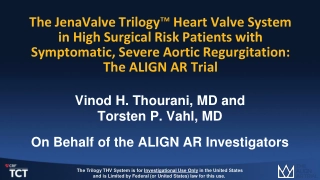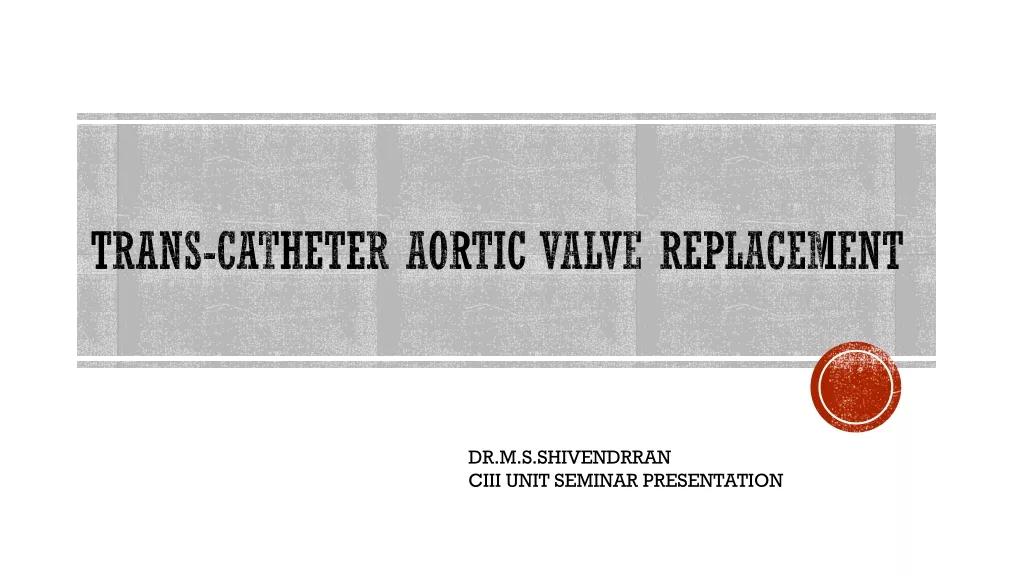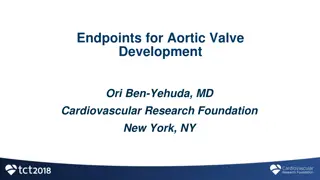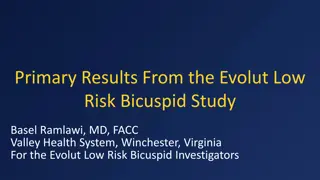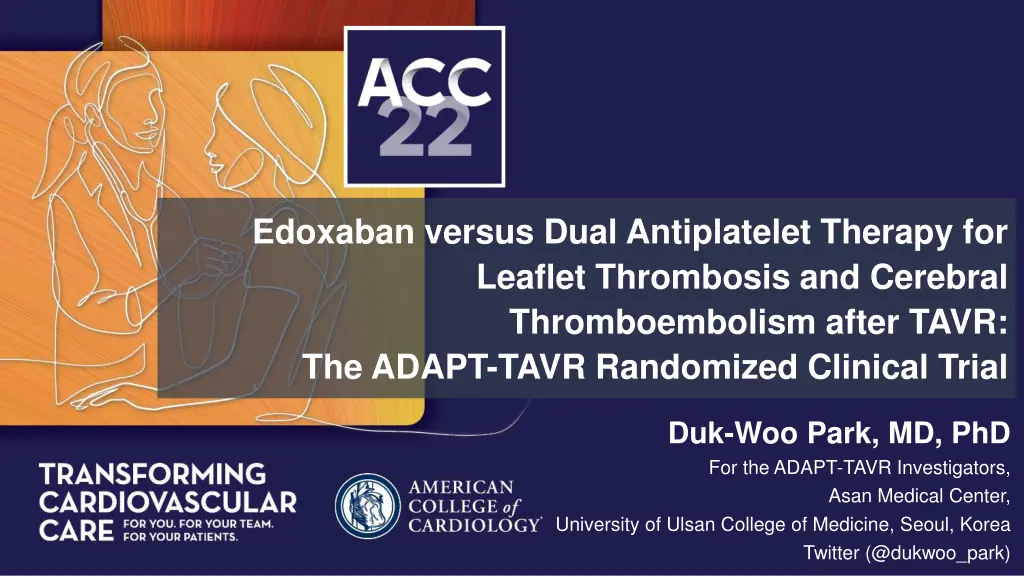
Edoxaban vs Dual Antiplatelet Therapy for Leaflet Thrombosis and Cerebral Thromboembolism After TAVR
Explore the ADAPT-TAVR trial comparing edoxaban and dual antiplatelet therapy in preventing leaflet thrombosis and cerebral thromboembolism post-TAVR. Investigate subclinical leaflet thrombosis and its association with neurological dysfunction. Study design, objectives, and key findings are detailed, highlighting the importance of anticoagulant therapy in TAVR patients.
Download Presentation

Please find below an Image/Link to download the presentation.
The content on the website is provided AS IS for your information and personal use only. It may not be sold, licensed, or shared on other websites without obtaining consent from the author. If you encounter any issues during the download, it is possible that the publisher has removed the file from their server.
You are allowed to download the files provided on this website for personal or commercial use, subject to the condition that they are used lawfully. All files are the property of their respective owners.
The content on the website is provided AS IS for your information and personal use only. It may not be sold, licensed, or shared on other websites without obtaining consent from the author.
E N D
Presentation Transcript
Edoxaban versus Dual Antiplatelet Therapy for Leaflet Thrombosis and Cerebral Thromboembolism after TAVR: The ADAPT-TAVR Randomized Clinical Trial Duk-Woo Park, MD, PhD For the ADAPT-TAVR Investigators, Asan Medical Center, University of Ulsan College of Medicine, Seoul, Korea Twitter (@dukwoo_park)
Disclosure The ADAPT-TAVR trial was an investigator-initiated trial and was funded by the CardioVascular Research Foundation (Seoul, Korea) and Daiichi Sankyo Korea Co., Ltd. The funders assisted in the design of the protocol but had no role in the conduct of the trial or in the analysis, interpretation, or reporting of the results.
Subclinical Leaflet Thrombosis (SLT) after TAVR1-4 What Is Known? What Is Unknown? Unknown Causal relationship of SLT with cerebral embolism Cerebral thromboembolism Stroke or TIA SLT OAC therapy SLT, subclinical leaflet thrombosis; OAC, oral anticoagulation; TAVR, transcatheter aortic valve replacement; TIA, transient ischemic attack. 1Makkar RR, et al. NEJM. 2015;373:2015-2024. 2Chakravarty T, et al. Lancet 2017;389:2383-2392. 3Makkar RR, et al. JACC 2020;75:3003-3015. 4Bogyi M, et al. JACC: Cardiovascular Interventions 2021;14:2643-2656.
Study Objectives to investigate the effect of edoxaban compared to Primary objective DAPT for the prevention of leaflet thrombosis and the potential risks of cerebral thromboembolization and neurological or neurocognitive dysfunction in patients without an OAC indication after TAVR. to determine the causal association of subclinical Secondary objective leaflet thrombosis with cerebral thromboembolism and neurological or neurocognitive dysfunction. DAPT, dual antiplatelet therapy; OAC, oral anticoagulation; TAVR, transcatheter aortic valve replacement
Study Design ADAPT-TAVR Trial: Anticoagulant versus Dual Antiplatelet Therapy for Preventing Leaflet Thrombosis After Transcatheter Aortic Valve Replacement 220 patients without OAC indication after successful TAVR Stratified randomization by (1) device type and (2) participating site NOAC: DAPT: Edoxaban 60 mg or 30 mg once daily* (N=110) ASA plus Clopidogrel (N=110) Mandatory evaluations: 4D, Cardiac CT at 6-Mo after TAVR - - Serial brain MRI and neurological/neurocognitive function tests at baseline and 6-Mo *30 mg once daily if moderate or severe renal impairment (creatinine clearance 15 50 mL/min), low body weight 60kg, or concomitant use of P-glycoprotein inhibitors (cyclosporin, dronedarone, erythromycin, ketoconazole). Park H et al. BMJ Open. 2021;11:e042587
Inclusion and Exclusion Criteria KEY EXCLUSION INCLUSION 1. Man or woman ( 18 years) with symptomatic AS 1. Any established indication for anticoagulation (e.g., atrial fibrillation) 2. Any absolute indication for DAPT (e.g., ACS or recent PCI) 3. Severe renal insufficiency prohibiting CT imaging (eGFR<30) 4. Contraindication to aspirin, clopidogrel or edoxaban 5. Known bleeding diathesis 6. Clinically overt stroke within 3 months 7. Moderate and severe hepatic impairment or any hepatic disease associated with coagulopathy 8. Active malignancy 2. Have a successful TAVR of an aortic valve stenosis (either native of valve-in-valve), defined as: Correct positioning of a single prosthetic heart valve into the proper anatomical location.1 Intended performance of the prosthetic heart valve - presence of all 3 conditions post-TAVR: o Mean aortic valve gradient < 20 mmHg o Peak transvalvular velocity (aortic valve maximum velocity) < 3.0 m/s o No severe or moderate aortic valve regurgitation Without unresolved periprocedural complications 3. With any approved/marketed TAVR device 1Kappetein AP, et al. J Am Coll Cardiol. 2012;60:1438-1454. Park H et al. BMJ Open. 2021;11:e042587
Study Endpoints Primary endpoint Incidence of leaflet thrombosis on 4D, volume-rendered CT at 6 months Secondary endpoints Presence and number/volume of new cerebral lesions on brain MRI Serial change of neurological/neurocognitive assessment (NIHSS, mRS, and MoCA) Clinical safety and efficacy outcomes Serial echocardiographic parameters NIHSS, National Institutes of Health Stroke Scale; mRS, modified Rankin Scale; MoCA, Montreal Cognitive Assessment Park H et al. BMJ Open. 2021;11:e042587
Enrollment: 5 centers, 3 countries Asan Medical Center - DW Park, SJ Park CHA Bundang Medical Center - WJ Kim, SH Kang Queen Mary Hospital - SCC Lam, AYT Wong Hong Kong Hong Kong Cheng Hsin General Hospital - WH Yin, J Wei, YT Lee National Taiwan University Hospital - HL Kao, MS Lin, TY Ko Executive Committee: DW Park (Trial PI), SJ Park, SCC Lam, WH Yin, HL Kao, WJ Kim Data Monitoring Committee: MS Lee (Chairperson), BK Koo, YG Ko, YH Jeong, JH Kim Clinical Events Committee: CH Lee (Chairperson), JH Lee, JH Kim Imaging (CT and MRI) Core Lab: Asan Image Metrics (Imaging Corelab), KW Kim (Chairperson), DH Yang (CT corelab), SC Jung (MRI corelab) Neurocognitive function and echo Core Lab: JH Lee (Chair, Neurology Corelab), SA Lee (Chair, Echo. Corelab)
Sample Size & Statistical Analysis Under an assumption that an incidence of leaflet thrombosis of 15% in the DAPT group and 3% in the NOAC (edoxaban) group based on prior data,1 a total sample of 220 patients was deemed to be sufficient to evaluate the primary endpoint with a statistical power of 80%, a 2-sided significance level of 0.05 and attrition rate of 10% (CT follow-up loss). The final sample size was also met to demonstrate that the edoxaban group would provide a 30% reduction of the number of new cerebral lesions on MRI compared to the DAPT group based on prior available data2-3 The main analyses were performed according to the ITT principle and secondary analyses were performed in the PP population ITT, intention-to-treat; PP, per-protocol. 1Chakravarty T, et al. Lancet 2017;389:2383-2392. 2Haussig S, et al. JAMA 2016;316:592-601. 3Kapadia SR, et al. JACC 2017;69:367-377 . Park H et al. BMJ Open. 2021;11:e042587
769 Patients were assessed for eligibility CONSORT Diagram 534 Were not eligible 127 Did meet inclusion and exclusion criteria, but refused to participate in the trial 407 Had exclusion criteria* 129 Had clinical indications for long-term anticoagulation 105 Had absolute indications for dual- antiplatelet therapy 51 Had severe renal insufficiency 97 Had bleeding risks or systemic conditions 69 Had other exclusion criteria 235 Patients underwent randomization 115 Were assigned to receive edoxaban 120 Were assigned to receive DAPT 4 Withdrew written informed consent during the index hospitalization 2 Withdrew written informed consent during the index hospitalization 118 Were eligible for analysis (the intention-to-treat population) 111 Were eligible for analysis (the intention-to-treat population) N = 1 N = 3 Drug cross-over N = 4 N = 9 Treatment per protocol < 80% of time Edoxaban group (N = 101) (the per-protocol population) DAPT group (N = 111) (the per-protocol population)
Baseline Characteristics, ITT Population Edoxaban group (N=111) DAPT Edoxaban group (N=111) DAPT group (N=118) group (N=118) Clinical characteristics Age, years Male sex Body weight 60kg STS risk score EuroSCORE II value NYHA class III or IV Diabetes mellitus Coronary artery disease Prior PCI Prior cerebrovascular dis. Peripheral artery disease Chronic lung disease Creatine clearance (ml/min) Creatine clearance 50 Use of low-dose edoxaban Procedural characteristics Pre-TAVR balloon angioplasty Valve type Balloon-expandable Self-expandable Valve-in-valve Transfemoral approach MAC anesthesia New permanent pacemaker Post-TAVR echo characteristics AV area, cm2 Mean AV gradient, mmHg LVEF, % Paravalvular aortic regurgitation Mild Moderate or severe 80.2 5.2 49 (44.1%) 55 (49.6%) 3.1 2.1 2.3 3.5 30 (27.0%) 35 (31.5%) 32 (28.8%) 18 (16.2%) 6 (5.4%) 7 (6.3%) 25 (22.5%) 61.0 21.5 38 (34.2) 68 (61.3%) 80.0 5.3 47 (39.8%) 63 (53.4%) 3.5 2.7 2.4 2.1 31 (26.3%) 36 (30.5%) 34 (28.8%) 14 (11.9%) 11 (9.3%) 11 (9.3%) 31 (26.3%) 59.2 18.7 47 (39.8) - 40 (36.0%) 41 (34.8%) 101 (91.0%) 10 (9.0%) 0 (0.0) 110 (99.1%) 84 (75.7%) 13 (11.7%) 105 (89.0%) 13 (11.0%) 4 (3.4%) 117 (99.2%) 92 (78.0%) 13 (11.0%) 1.7 0.4 13.4 5.1 64.4 10.0 1.6 0.4 14.3 5.4 64.2 9.5 105 (97.2%) 3 (2.8%) 112 (97.3%) 3 (2.7%) AV, aortic valve; LVEF, left ventricular ejection fraction; MAC, Monitored anesthetic care; NYHA, New York Heart Association; PCI, percutaneous coronary intervention; STS, Society of Thoracic Surgeons; TAVR, transcatheter aortic valve replacement.
Completeness of Imaging & Neurocognitive Assessment Measurement Cardiac CT Brain MRI NIHSS mRS MoCA Post-TAVR (98.3%) (98.3%) (98.3%) (98.3%) (~ before Discharge) 6-Mo follow-up (95.9%) (96.4%) (95.5%) (95.5%) (95.5%) Completeness of 95.9% 93.7% 93.7% 93.7% serial evaluations* * Completeness of imaging or neurological assessments at 6 months was estimated among eligible patients who were alive at 6 months and did not withdraw during follow-up. NIHSS, National Institutes of Health Stroke Scale; mRS, modified Rankin Scale; MoCA, Montreal Cognitive Assessment
4D-CT Primary End Points Valve Leaflet Thrombosis, ITT Population Valve Leaflet Thrombosis, PP Population 40.0 Risk difference (%), -8.5 (-17.8; 0.7) Risk ratio, 0.53 (0.26-1.09) P=0.076* Risk difference (%), -10.0 (-19.4; -0.6) Risk ratio, 0.48 (0.23-0.99) P=0.047* Patients (%) 30.0 19.1 18.4 20.0 9.8 9.1 10.0 0.0 Edoxaban 109 DAPT No. of Patients 102 The degree of hypoattenuated leaflet thickening and the severity of reduced leaflet motion were classified according to the standard definition (Blanke P, et al. JACC Cardiovasc Imaging. 2019;12:1-24) 99 105 *P values are derived from the chi-square test or Fisher s exact test as appropriate.
4D-CT Outcomes 30.0 Reduced Leaflet Motion Grade 3, ITT Population Reduced Leaflet Motion Grade 3, PP Population Patients (%) Risk difference (%), -4.4 (-10.3; 1.5) Risk ratio, 0.40 (0.11-1.47) P=0.15 Risk difference (%), -4.6 (-10.7; 1.5) Risk ratio, 0.40 (0.11-1.46) P=0.15 20.0 10.0 7.6 7.3 3.0 2.9 0.0 Edoxaban 109 DAPT No. of Patients 102 The degree of hypoattenuated leaflet thickening and the severity of reduced leaflet motion were classified according to the standard definition (Blanke P, et al. JACC Cardiovasc Imaging. 2019;12:1-24) 99 105 *P values are derived from the chi-square test or Fisher s exact test as appropriate.
MRI End Points, ITT Analysis Presence of New Cerebral Lesions Median Number of Total New Lesions Median Volume of Total New Lesions (mm3) P=0.88 P=0.85 P=0.40 40 / 500 450 / 36.6 400 / 30 [13.7, 145.0] Volume (mm3) Patients (%) 1 [1, 2] 1 [1, 3] 350 25.0 43.9 Number / 300 [23.5, 83.5] 20.2 / 20 250 200 / 150 / 10 100 / 50 / 0 0 Edoxaban DAPT 109 Edoxaban 104 DAPT 109 Edoxaban 104 DAPT 109 No. of Patients 104 P values are derived from the chi-square test or Fisher s exact test as appropriate. Median differences calculated as independent samples Hodges-Lehmann median difference estimates.
Neurological & Neurocognitive End Points, ITT Analysis Worsening of NIHSS Scale Worsening of Modified Rankin Scale Worsening of Montreal Cognitive Assessment 40 P=0.20 30.0 30 Patients (%) 22.2 20 P=0.74 P=0.69 10 5.0 3.7 2.0 0.9 0 Edoxaban DAPT 108 100 108 100 100 108 No. of Patients NIHSS, National Institutes of Health Stroke Scale P values are derived from the chi-square test or Fisher s exact test as appropriate. Worsening is defined as 1 point increase in NIHSS, 1 point increase in modified Rankin scale, or 1 point decrease in Montreal Cognitive Assessment scores as compared to baseline.
Association of Severity of HALT with Extent of New Lesions on Brain MRI Number of New Lesions Number of New Lesions Number of New Lesions on DWI-MRI on FLAIR-MRI on GRE-MRI N 209 209 209 Number of HALT Spearman Rho 0.09 -0.04 -0.02 Per-Patient P-Value 0.19 0.60 0.81 HALT, hypoattenuated leaflet thickening; DWI, diffusion weighted image; FLAIR, fluid attenuated inversion recovery; GRE, gradient echo; MRI, magnetic resonance imaging
Association of Severity of HALT with Decline of Neurological Assessments Serial Change of Serial Change of Serial Change of NIHSS Score 204 mRS Score 204 MOCA Score 204 N Number of HALT 0.01 0.02 0.03 Spearman Rho Per-Patient 0.94 0.77 0.68 P-Value HALT, hypoattenuated leaflet thickening; NIHSS, National Institutes of Health Stroke Scale; mRS, modified Rankin Scale; MoCA, Montreal Cognitive Assessment
Clinical Outcomes at 6 Month, ITT Population Edoxaban group (N=111) n (%) DAPT group (N=118) n (%) Risk Difference (95% CI) Hazard Ratio (95% CI) Outcomes* Efficacy Outcomes Death Cardiovascular death Non-cardiovascular death Stroke Ischemic Hemorrhagic Myocardial infarction Systemic thromboembolic event Safety Outcomes Bleeding events Minor bleeding Major bleeding Life-threatening or disabling bleeding Rehospitalization 3 (2.7%) 3 0 2 (1.8%) 2 0 1 (0.9%) 2 (1.8%) 2 (1.7%) 0 2 2 (1.7%) 2 0 3 (2.5%) 0 (0) 1.0 (-2.8; 4.8) 1.48 (0.25-8.75) 0.1 (-3.3; 3.5) 1.05 (0.15-7.45) -1.6 (-4.9; 1.7) 1.8 (-0.8; 4.4) 0.45 (0.05-3.83) not applicable 13 (11.7%) 7 6 0 17 (15.3%) 15 (12.7%) 11 3 1 14 (11.9%) -1.0 (-9.5; 7.5) 0.93 (0.44-1.96) 3.5 (-5.4; 12.3) 1.29 (0.67-2.49) * Clinical end points were adjudicated according to the VARC-2 and VARC-3 definitions. Hazard ratio (for edoxaban compared to DAPT) and corresponding 95% CI was calculated by the Cox proportional hazards models.
Limitations This trial was an open-label trial, which was potentially subject to reporting and ascertainment bias. Our trial adopted surrogate imaging end points; thus, our study was underpowered to detect clinically relevant differences in efficacy and safety outcomes. Follow-up period was relatively short; the long-term effect of leaflet thrombosis or antithrombotic strategies on valve durability is unknown. Our findings cannot be directly applied in patients with clinical indications for OAC (approximately, one third of TAVR patients).
Conclusions The overall incidence of leaflet thrombosis on CT scans was less frequent (8.5% difference; risk ratio of 0.53) with the edoxaban therapy than with the DAPT therapy, although it did not reach statistical significance. The incidence of new cerebral thromboembolism on brain MRI and new development of neurological or neurocognitive dysfunction were not different between two groups. There was no causal association of leaflet thrombosis with temporal- related changes of new cerebral thromboembolism and neurological end points.
Further Details Park DW, et al. Circulation 2022:April 4th, On-line
Background The incidence of subclinical leaflet thrombosis by 4D-CT was not uncommon (approximately 10%~30%) and this phenomenon could be associated with increased risks of cerebral thromboembolism, stroke or TIA.1-4 However, the causal relationship of leaflet thrombosis with cerebral embolic risk and neurological/neurocognitive dysfunction in patients undergoing TAVR is still unclear. Several RCTs have tested that NOAC-based strategy is more effective than conventional antithrombotic strategies for the prevention of leaflet thrombosis and thromboembolic risk in patients with or without OAC indication after TAVR.5-8 4D-CT, four-dimensional computed tomography; NOAC, non-vitamin K direct anticoagulant; OAC, oral anticoagulation; RCTs, randomized controlled trials; TAVR, transcatheter aortic valve replacement; TIA, transient ischemic attack. 1Chakravarty T, et al. Lancet 2017;389:2383-2392. 2Rashid HN, et al. EuroIntervention 2018;13:e1748-e1755. 3Makkar RR, et al. JACC 2020;75:3003-3015. 4Bogyi M, et al. JACC: Cardiovascular Interventions 2021;14:2643-2656. 5Dangas GD et al. NEJM 2020;382:120-129. 6Collet JP. et al. ATLANTIS trial. ACC 2021. 7De Backer O et al. NEJM 2020;382:130-139. 8Van Mieghem NM et al. NEJM 2021; 385:2150-2160.
Clinical Implications Subclinical leaflet thrombosis has not been proven to affect the clinical outcomes for patients who underwent TAVR, and thus this imaging phenomenon should not dictate the antithrombotic therapy for its prevention after TAVR. The absence of evidence of temporally related adverse clinical sequelae of imaging-detected subclinical leaflet thrombosis does not support the routine imaging screening tests for the detection of this phenomenon and imaging-guided antithrombotic strategies in cases without hemodynamic or clinical significance.

